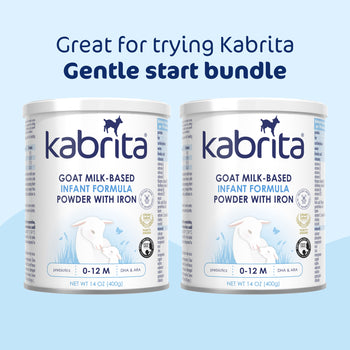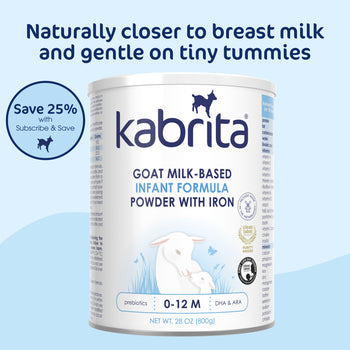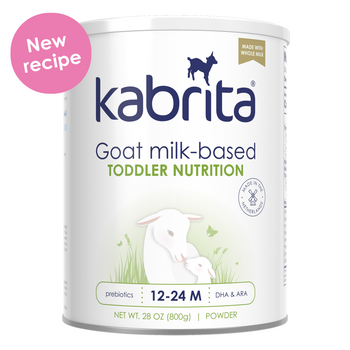Comparing Leading US and European Formulas

Information for Health Professionals
Choosing the ideal formula for a healthy baby or baby with minor issues may be difficult for some parents and healthcare practitioners. We’ve reviewed important attributes to consider among commons formulas.
Download 'Leading US & European Formula Comparison' Chart
Easier to Digest Protein
Goat milk protein forms a smaller, softer, and looser curd in the stomach compared to cow milk protein1. Additionally, studies have shown that goat milk protein is digested more quickly than cow milk protein2. Kabrita Goat Milk Toddler Formula contains easy to digest goat milk protein*.
Whey Added to Improve Digestibility
In contrast to breast milk, both cow and goat milk has less whey than casein. To model the whey to casein ratio found in breast milk, some formulas add whey protein. Increasing the whey component helps the formula to coagulate less in the gut and be digested faster3, which may be desirable. Kabrita Goat Milk Toddler Formula contains added goat whey protein.
No Added Refined Sugars
Lactose is the primary carbohydrate found in breast milk and the optimal source of carbohydrates for most healthy babies. True lactose intolerance is uncommon under 2 or 3 years of age4. Kabrita Goat Milk Toddler Formula uses lactose as the primary carbohydrate, with no added refined sugars such as maltodextrin or sucrose.
Fat Modeled after the Fat in Breast Milk
High 2-palmitic acid, or beta palmitate, contains triglycerides with a unique structure that models the triglyceride structure found in breastmilk. Formulas with a fat blend containing beta palmitate have been associated with improved calcium and fat absorption5, as well as softer stool consistency6. Kabrita Goat Milk Toddler Formula is one of the few formulas in the US to use a premium fat blend with beta palmitate.
DHA for Eye and Brain Health
DHA (docosahexaenoic acid) is an omega 3 fatty acid that supports normal eye7 and neurological development8 in children. Kabrita Goat Milk Toddler Formula contains 23 mg of DHA per two 4-oz servings.
Prebiotics to Support Gut Flora
Prebiotics are non-digestible food ingredients that selectively stimulated the favorable growth and activity of beneficial gut microflora9. Goat milk has been shown to contain 6x the amount of prebiotic oligosaccharides compared to cow milk10, and Kabrita Goat Milk Toddler Formula contains added prebiotic galactooligosaccharides (GOS).
Made in Europe
European food standards are higher than the US with regards to genetic modification and pesticide use, leading many parents to look for European quality products. Kabrita Goat Milk Toddler Formula is made in the Netherlands using high-quality Dutch goat milk, and readily available in the US.
No GMO Ingredients
Many families are looking for foods without genetically modified ingredients. GMO standards and requirements vary by country. Kabrita Goat Milk Toddler Formula uses goat milk from the Netherlands where GMO crops are prohibited, is made in the Netherlands, and contains no GMO ingredients.
Meets USA Infant Formula Nutrient Guidelines
In the US, the FDA mandates the amount and types of nutrients required in infant formula and has other important requirements before bringing to market a new infant formula. Kabrita Goat Milk Toddler Formula meets the FDA nutrient guidelines for infant formula, however, it has not gone through the FDA evaluation process that is required for infant formula. We hope to bring our infant formula to parents and healthcare practitioners in the US in the near future.
Practitioners across the US are recommending Kabrita Goat Milk Toddler Formula in cases of minor issues associated with cow milk, for supplementing and weaning, and as a nutritious cow milk alternative.
*Goat milk products are not recommended in cases of cow milk protein allergy (CMPA).
1. Park YW. Hypo-allergenic and therapeutic significance of goat milk. 1994 Small Rumin. Res.14,151–16
2. Almaas H, eta l. In vitro digestion of bovine and caprine milk by human gastric and duodenal enzymes. Int Dairy J. 2006;16:961–68.
3. Ye, A et al. (2019). Dynamic in vitro gastric digestion of infant formulae made with goat milk and cow milk: Influence of protein composition. Int Dairy J. 2019;97:76-85
4. Heyman MB (Committee on Nutrition). Lactose intolerance in infants, children, and adolescents. Pediatrics, 2006. Sep; 118(3):1279-86.
5. Carnielli VP, et al. Structural position and amount of palmitic acid in infant formulas: effects on fat, fatty acid, and mineral balance. J Pediatr Gastroenterol Nutr. 1996 Dec; 23(5):553-60.
6. Kennedy, k, et al. Double-blind randomized trial of a synthetic triacylglycerol in formula-fed term infants: effects on stool biochemistry, stool characteristics, and bone mineralization. Am J Clin Nutr 1999;70:920-7.
7. Uauy R, et al. Term infant studies of DHA and ARA supplementation on neurodevelopment: results of randomized controlled trials. J Pediatr. 2003 Oct;143(4Suppl):S17-25.
8. EFSA Panel on Dietetic Products, Nutrition and Allergies (NDA). Scientific Opinion on the substantiation of a health claim related to DHA and contribution to normal brain development pursuant to Article 14 of Regulation (EC) No 1924/2006. Oct 2014;12(10).
9. Thomas, D. W., Greer, F. R., American Academy of Pediatrics Committee on, N., American Academy of Pediatrics Section on Gastroenterology, H., and Nutrition. (2010) Probiotics and prebiotics in pediatrics. Pediatrics 126, 1217-1231
10. Urashima, T., & Taufik, E. (2011). Oligosaccharides in Milk: Their Benefits and Future Utilization. Media Peternakan,33(3),189.



